Terry L. Ettinger Horticulture Consulting Services
Meeting The Needs Of Today With A Vision For The Future
Question of the Week
Winterizing Roses
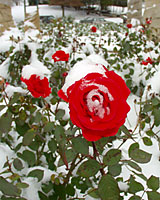 Q. We planted a number of roses (a couple of climbers, six hybrid teas, three Fairy roses, and three or four
miniatures) around our home this past spring. Since the beginning of November my wife's been after me to get them covered
before the snow flies. Well, the snow has now flown but I still haven't taken care of our roses. If it's not too late,
can you tell me how to protect these roses for the winter?
Q. We planted a number of roses (a couple of climbers, six hybrid teas, three Fairy roses, and three or four
miniatures) around our home this past spring. Since the beginning of November my wife's been after me to get them covered
before the snow flies. Well, the snow has now flown but I still haven't taken care of our roses. If it's not too late,
can you tell me how to protect these roses for the winter?
A. It sounds like you and I are in the same boat with our wives. Don't you hate it when we give them the opportunity to say "I told you so!" Fortunately, the good news is that there's still time to get these beautiful flowering shrubs ready for the brunt of winter that's yet to come.
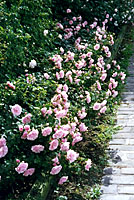 Even better news for you is that `Fairy'
and miniature roses are very hardy. Along with many other shrub
roses such as the new `Knockout' series, `Bonica' (at left) and
rugosa roses, you really don't
need to do anything to get them ready for harsh winter weather! If, however, it will make you (or your wife) feel better,
cut their canes back by about half. Provided that you planted them in a location where the soil is well-drained, they
should make it through the winter with absolutely no problem.
Even better news for you is that `Fairy'
and miniature roses are very hardy. Along with many other shrub
roses such as the new `Knockout' series, `Bonica' (at left) and
rugosa roses, you really don't
need to do anything to get them ready for harsh winter weather! If, however, it will make you (or your wife) feel better,
cut their canes back by about half. Provided that you planted them in a location where the soil is well-drained, they
should make it through the winter with absolutely no problem.
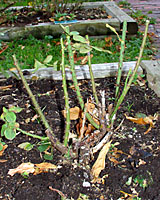 The process is pretty much the same with the less hardy hybrid tea, grandiflora and floribunda roses. Simply cut
them back to a height of twelve to eighteen inches to prevent heavy snows from snapping off the canes.
The really serious pruning will take place once the extent of winter
injury can be determined.
The process is pretty much the same with the less hardy hybrid tea, grandiflora and floribunda roses. Simply cut
them back to a height of twelve to eighteen inches to prevent heavy snows from snapping off the canes.
The really serious pruning will take place once the extent of winter
injury can be determined.
Meanwhile, getting your climbing roses winterized requires a little more effort.
If they're trained up and over an arching trellis, simply bundle their canes tight against the trellis with cotton twine. If, on the other hand, they're trained along a fence or flat trellis, carefully take the canes off the trellis and bundle them together with cotton twine.
 Once the canes are bundled together, wrap them with several layers of burlap (you can find rolls of burlap at most farm
supply stores, garden centers and home improvement centers) and secure with cotton twine. You can then take the bundled
canes that were trained to a fence or flat trellis and tie them upright to a stake driven into the ground next to the plant
(take care not to damage the roots of your climbers), or lay them on the ground (being careful not to break them by bending
them too severely).
Once the canes are bundled together, wrap them with several layers of burlap (you can find rolls of burlap at most farm
supply stores, garden centers and home improvement centers) and secure with cotton twine. You can then take the bundled
canes that were trained to a fence or flat trellis and tie them upright to a stake driven into the ground next to the plant
(take care not to damage the roots of your climbers), or lay them on the ground (being careful not to break them by bending
them too severely).
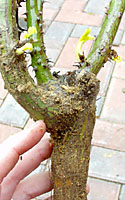 Finally, to protect cold-sensitive bud unions of your roses (the slightly swollen point near the soil line,
at right, where the
desirable above-ground canes are budded or grafted to disease-resistant root systems), carefully pile a couple of
shovelfuls of compost, sawdust, manure, Nutribrew, peatmoss and/or soil around the base of each plant,
below left. These materials,
in combination with the winter's blanket of snow will keep the bud union at a relatively constant temperature somewhere
slightly below freezing - even if air temperatures drop well below zero. Next spring as the temperatures warm, you can wash
these materials off of the canes with a strong spray of water from your garden hose, but leave them around the base of
your roses as mulch!
Finally, to protect cold-sensitive bud unions of your roses (the slightly swollen point near the soil line,
at right, where the
desirable above-ground canes are budded or grafted to disease-resistant root systems), carefully pile a couple of
shovelfuls of compost, sawdust, manure, Nutribrew, peatmoss and/or soil around the base of each plant,
below left. These materials,
in combination with the winter's blanket of snow will keep the bud union at a relatively constant temperature somewhere
slightly below freezing - even if air temperatures drop well below zero. Next spring as the temperatures warm, you can wash
these materials off of the canes with a strong spray of water from your garden hose, but leave them around the base of
your roses as mulch!
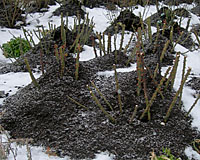 If the above description and accompanying photos don't provide clear instructions, take a walk through the
E.M. Mills
Rose Garden in the southwest corner of Thornden Park in Syracuse (at the intersection of Ostrum Avenue and
University Place along the east edge of the Syracuse University campus). There the Syracuse Rose Society uses these
techniques to protect approximately 3,500 roses from the worst our Central New York winters have to offer!
If the above description and accompanying photos don't provide clear instructions, take a walk through the
E.M. Mills
Rose Garden in the southwest corner of Thornden Park in Syracuse (at the intersection of Ostrum Avenue and
University Place along the east edge of the Syracuse University campus). There the Syracuse Rose Society uses these
techniques to protect approximately 3,500 roses from the worst our Central New York winters have to offer!